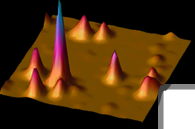PHOTON ANTIBUNCHING IN SINGLE CdSe/ZnS QUANTUM
DOT FLUORESCENCE
B. Lounis, H. A. Bechtel, D. Gerion, P. Alivisatos, and W. E.
Moerner, Chem. Phys. Lett., in press
We investigate the fluorescence intensity correlation function
of a single CdSe quantum dot using a start-stop experiment. We
observe strong photon antibunching, a signature of non-classical
light emission, over a large range of intensities (0.1-100 kW/cm2).
The lack of coincidence at zero time delay indicates a highly
efficient Auger ionization process, which suppresses multi-photon
emission in these colloidal quantum dots. Using careful analysis
of the saturation behavior of the coincidence histograms, the
absorption cross section of a single quantum dot has also been
derived.

Figure 1: Histogram of time delays between consecutive
photon pairs (which is proportional to the intensity correlation
function) detected from the fluorescence of a single CdSe
QD. The time bin size is 0.2 ns, the excitation intensity
is 11 kW/cm2, and the accumulation time is 430 s. The histogram
shows a dip that approaches zero (actual value~3) at zero
time delay, which is a clear signature of photon antibunching.
The solid line represents a single exponential fit with
a rise time constant of 16 (±1) ns. |
|



